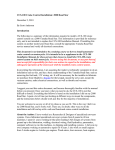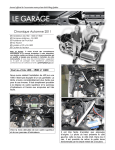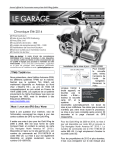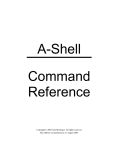Download Audiovox CCS-100 Instruction manual
Transcript
Why use Murphs CCS-100 Cruise instead of the Rostra Electronic Cruise ? Murphs CCS-100 controls engine speeds using a tachometer signal and engine vacuum to control vehicle speed. The Rostra Electronic Cruise uses a VSS (Vechicle Speed Sensor) signal, and a tachometer signal to control vehicle speed. The Rostra needs both signals to operate. Older vehicles and many motorcycles don’t have a VSS (Vehicle Speed Sensor. If you want cruise on any manual transmission vehicle without a VSS (Vehicle Speed Sensor Murphs CCS-100 Cruise Control is the simplest solution. On vehicles with a VSS (Vehicle Speed Sensor) you can use either Murphs CCS-100 Cruise or the Rostra Electronic Cruise. Use the Rostra Electronic Cruise if you live at high altitudes. Some have reported problems holding speed at high altitudes with the original CCS-100 due to lower vacuum at high altitudes. Then again, others have reported no altitude problems at all. How the Murphs CCS-100 Cruise Works The cruise monitors engine RPM through the blue wire connected to your tachometer or coil wire. Without a tachometer signal the cruise won’t work. The Cruise servo cable uses engine vacuum to move your throttle. Without engine vacuum the cruise won’t work. The purple or brake light wire allows the cruise to turn on and shuts the cruise off when you apply the brakes. If the purple brake wire is not connected correctly the cruise either won’t turn on or won’t shut off. You can always shut the cruise off by turning the cruise off at the control keypad. To summarize, you need a tachometer signal to the blue wire, engine vacuum connected to the servo, and the purple brake wire connected correctly for the cruise to work. If you don’t have all three, the cruise won’t work. 1 Before you start your Installation Do some online research. The Murphs CCS-100 and the original Audiovox CCS-100 have been successfully installed on thousands of vehicles. A simple Google search might find online instructions already posted on your vehicle. Just search for your vehicle ccs-100 cruise control installation or your vehicle cruise control. Another good source for information on cruise control installation is the numerous online vehicle specific forums. See if your vehicle has an online forum. If you have problems, the forum on your vehicle might be your best source for troubleshooting. It’s much easier to follow someone’s instructions than to install the cruise completely on your own. In any case, you will need the original CCS-100 instructions for reference. Download them at: http://www.murphskits.com/catalog/docs/cc100_ins.pdf If the link above does not work search for CCS-100 manual You need the original CCS-100 manual because it shows you how to set the dip switches in the cruise servo. If you are installing the cruise in an automobile it also shows you several methods of attaching the cruise control cable and how to use the accessory VSS (Vehicle Speed Sensor) connections. For standard transmission automobiles you can just use a tachometer signal to control speed. For automatic transmission automobiles, you have to use the accessory VSS (Vehicle Speed Sensor) connections. Follow the instructions in the CCS-100 Manual. Using the VSS signal on a standard (manual) transmission vehicles Murphs CCS-100 and the original Audiovox CCS-100 have a quirk when using the VSS signal for a standard manual transmission. When you set the dip switches for VSS signal, the cruise completely ignores the tachometer signal from the blue wire. On a standard manual transmission, the engine will rev up as you shift gears. It’s normal and there is nothing you can do to fix it. The solution is to tap the brake or turn the cruise off before you shift gears. The engine will not rev up this way as you shift. If you are using the VSS signal, you do not have to connect the blue tachometer wire. 2 If you are doing a cruise installation without following someone’s instructions you might need a copy of the wiring diagram for your vehicle. Do a Google search, it might be online. You need to know the wire colors of the following: The negative terminal of the coil wire color or the vehicle tachometer wire color. (The blue tachometer wire from the Cruise Control is connected here) A switched power source, a circuit that turns on with the key. Any switched circuit will work just don’t use the headlight circuit. That might not be safe if a fuse blows. You can also use a digital VOM to find this wire. (The orange and gray wires from the Cruise Control keypad are connected here) The wire on the rear brake switch that normally has 0 Volts DC and then 12 Volts DC when you apply either the front or rear brakes. You can use a digital VOM to find this wire You can also use the brake wire running to the taillight (If you do, you’ll need a SPDT relay in the circuit too). The purple cruise wire connects here. This is also the source of most cruise problems. Do some advance planning and determine where you are mounting the cruise servo and the vacuum reservoir. Both are about the size of a 15ounce soup can. If you are installing the cruise to a motorcycle, determine where you are mounting the cruise control keypad. Build a mount for the cruise control keypad if needed. The cruise control keypad can be installed anywhere as long as you don’t have to remove your right hand from the throttle to operate the keypad. Installation Tips Cruise Control Keypad: The orange and gray wire from the cruise control keypad needs to be connected to switched power. Switched power is a circuit that is on only when the ignition key is turned on. You can use any circuit including accessory leads or the wire running to your taillights (not brake lights). We strongly suggest you not use the headlight circuit for safety reasons. The orange wire is power for the cruise control. The gray wire is illumination (light) for the cruise control keypad. 3 Servo Dip Switch Settings: You need to set the servo DIP switches inside the servo housing for the cruise to work. You can’t just pull the servo out of the box and install it….the cruise won’t work. If you are following written instructions for your vehicle, set the dip switches as in the instructions. If you are using Tach only for your signal source, remember to pull the Black jumper to the left of the Dip switches inside the servo. For some reason we all forget to add that step when we write cruise instructions. If you are doing an installation on a motorcycle or standard transmission automobile without the benefit of following written instructions for your vehicle, start with these settings: SW1 ON SW2 OFF SW3 OFF SW4 OFF SW5 OFF SW6 OFF SW7 ON Broken down, the settings above are: SW1, SW2: 4000 PPM SW3: Tachometer only speed signal SW4, SW5: Medium Sensitivity SW6: Normally closed control switch. The keypad supplied with the cruise is a normally closed switch. SW7: Coil Tachometer source The only initial exceptions to the above are if you have a multi-cylinder vehicle with individual coils on each spark plug (also called stick coils) and you are taking the tachometer signal direct from the stick coil. Kawasaki C14 and 650 Versys are examples. For these vehicles, use a 2000 PPM setting: SW1 OFF SW2 OFF SW3 OFF SW4 OFF SW5 OFF SW6 OFF SW7 ON Broken down, the settings above are: SW1, SW2: 2000 PPM SW3: Tachometer only speed signal SW4, SW5: Medium Sensitivity SW6: Normally closed control switch. The keypad supplied with the cruise is a normally closed switch. SW7: Coil Tachometer source 4 Throttle connection: For automobiles, use the connection methods as described in the original CCS-100 manual at http://www.murphskits.com/catalog/docs/cc100_ins.pdf Motorcycles normally use either Throttle Wire Loop (Part # 29 in the original CCS-100 instruction manual) or the bead chain eyelet (Part #25 in the original CCS-100 instruction manual). Throttle Wire Loop example: http://www.murphskits.com/catalog/docs/audiovox/index.htm Bead chain eyelet example: http://www.murphskits.com/catalog/docs/c14cc-install.htm The Throttle Wire Loop is the simpler of the two methods but not all motorcycles have enough room next to the throttle opening cable for the Throttle Wire Loop. Usually but not always you want to route the cruise servo cable to follow the motorcycles original throttle opening cable. The servo cable needs to be able to move the throttle easily. After you’ve installed the cruise control servo cable, grab onto it with a pair of pliers, pull on the servo cable and try to open the throttle. If you can’t open the throttle relatively easily the cruise control probably won’t work. Try a different position for the cruise control servo cable until you find one that you can open the throttle easily. Most installations use 3-6 beads of bead chain (Part # 20in the original CCS-100 instruction manual) between the Bead chain eyelet or Throttle wire loop. You want just a little slack at idle in the cruise control servo cable (closed throttle position) but you must have enough slack that the throttle is fully closed. This is a trial and error process. Too much slack and the cruise will be slow to respond. Way too much slack and the cruise may not respond at all and the chance of the bead chain hanging on something increases. Tip: Spread the slots in the small Bead chain eyelet connector Part Number 25 and bead chain coupling Part Number 24 before installing them. This will allow the servo cable and bead chain to be inserted easily. After assembly squeeze the slots shut with pliers. It is extremely important that the throttle can not stick when the cruise control throttle connection is added. With the motorcycle off, turn the throttle to full open several times to verify that the throttle does not stick. If 5 it sticks, fix it before you ride. The cruise does not have to be on for the throttle to stick. Should the throttle ever stick, pull in the clutch first then hit the kill switch. Don’t expect the brakes to stop the motorcycle with a stuck throttle; most motorcycles are just too powerful. Vacuum Canister: You’ll need a vacuum canister. You can make one but if it leaks, the cruise won’t work. We suggest you buy one when you get your cruise control to use at least temporally for initial testing. On Murph’s Vacuum canister, the port marked MAN is connected to engine vacuum. The port marked AUX is connected to the vacuum port on the cruise servo. Get them backwards and the cruise won’t work. For automobiles, you can use any vacuum source with the exception of the vacuum line running to your power brake booster. It’s not safe to tap into your power brake vacuum booster line. Motorcycles normally use the ports on the carburetors or throttle bodies used for synchronization. They have rubber caps on them and you can just pull them off. Use vacuum from several carburetors / throttle bodies ports when you can. The more vacuum the better. Brake Wire Connection: The purple wire from the cruise control servo must be connected to the positive side of your brake switch. Normally the rear brake switch has the easiest access. Connect the purple cruise control wire to the side of the brake switch that usually has 0 Volts DC but +12 Volts DC when you step on the brakes. You can also connect the purple cruise control wire to your taillight brake wire but you’ll also need a SPDT relay in the circuit. If you have LED taillights or have even added accessory LED brake lights you need to use a relay. The purple cruise control wire can’t sense ground through an LED. Without being connected to Chassis Ground through the purple cruise control wire, the cruise won’t turn on. Not all SPDT relays are the same. Some SPDT relays for automotive lighting applications don’t have the correct internal configuration. You can buy Murph’s relay which has the correct configuration here: www.murphskits.com/catalog/product_info.php?cPath=25&products_id=22 1 6 How to hook up the brake SPDT relay is here: http://www.murphskits.com/catalog/docs/tail_light_relay.doc Note: The motorcycle taillight brake wire color of Blue with a Red Stripe before the connector and solid Blue after the connector is for a Kawasaki C14 only. Your taillight brake wire color will be different. It is CRITICAL that you verify that you have a good connection between the SPDT relay and the motorcycle brake light wire. This is the connection that shuts the cruise off when you press on either brake. After you have made all the connections verify proper operation by turning the ignition on with the engine off, press on the brake and you should hear Murphs’ accessory relay click. If you don’t hear a click, the relay is not working and the cruise might not shut off. Find the problem and fix it before you ride your bike. Also note that the motorcycle brake light must be working for the cruise to the cruise to work correctly. Pre-Ride Testing: After you have everything hooked up, verify proper operation of the Servo by removing the plate on the Servo housing where the wiring harness is installed. With the engine off and the ignition on. Turn on the cruise at the Cruise Control Keypad. Look into the servo housing where the wiring harness is installed. The Red LED should blink once as the Set and Resume buttons are pressed. Start the bike and leave it in neutral: Turn on the cruise and look into the servo housing where the wiring harness is installed. The Red LED should be blinking. Increase the engine RPM’s and the LED should flash faster. This confirms that you have a good tach signal. With the bike off but the cruise on: When you press on either brake the Red LED should be continuously lit. The Red Led should go out when you release the brakes. The Purple Servo wire must be connected to chassis ground for the Cruise to turn on. The Purple Servo wire must also have +12 VDC applied to it to shut the cruise off. That’s why you need the relay. If you pass these tests you’re ready for your test ride. If not, see the troubleshooting section below: 7 Note: You can’t road test the cruise control with the bike running on your centerstand. The cruise control has a built–in over-rev feature, it will shut its self off before you know it’s actually working. The Test Ride: Wear all your gear just in case. Should the throttle stick, pull in the clutch first then hit the kill switch. Don’t expect the brakes to stop the bike with a stuck throttle; your bike is just too powerful. The cruise will operate in any gear above about 30 MPH. Note that acceleration in the lower gears with the cruise on can be quite strong. On a straight level road with no traffic and in at least fourth gear at about 40 MPH set the cruise. The cruise should hold speed. Test that the cruise shuts off with either brake. Also test that the cruise shuts off with the clutch pulled in (The engine will rev up 500-1000 RPM before the cruise shuts off). If you have any problems fix the bike before you ride in traffic. If the cruise does not work at 40 MPH, try 60 MPH. If it works now your PPM setting is too high. Try the next lower PPM setting. If it works ok – Congratulations… You’re done If it doesn’t work or you need to tweak it see the Troubleshooting Instructions below: Troubleshooting 99.9% of all cruise control problems aren’t with the cruise control. The problem is with the installation or the installer. Before you return a “defective” cruise control use the following trouble shooting tips to try solve your problem: The Cruise Control does not work at all: Remember that you need a tachometer signal to the blue wire, engine vacuum connected to the servo, and the purple brake wire connected correctly for the cruise to work. If you don’t have all three, the cruise won’t work. Test for tachometer signal: Start the bike and leave it in neutral: Turn on the cruise and look into the servo housing where the wiring harness is installed. The Red LED should be blinking. Increase the engine RPM’s and the LED should flash faster. This confirms that you have a good tach signal. 8 If you don’t have a faster flashing LED, then you don’t have a good tach signal or the DIP switches in the Servo are set wrong. Check for a good connection at your Tachometer source. It’s fairly easy to not have a good connection when using the Scotch lock connectors. The Scotch lock connector needs to fit all the way over the wire you are connecting to and the other wire needs to be fully in the top side of the Scotch lock connector. Pull on the wires…If they come loose you found your problem. Did you pull the Black jumper to the left of the Dip switches inside the servo? If you still don’t have a tach signal. Are you really connected to the tachometer signal of the vehicle? Might be a good time to get on to your online vehicle forum and ask for advice. Vacuum Canister Test: Is port marked MAN is connected to engine vacuum and the port marked AUX is connected to the vacuum port on the cruise servo? Pull the Vacuum line off the Vacuum Canister and start the vehicle. Seal off the end off the vacuum line to the engine with you finger. Do you feel suction? If you do, then you have Vacuum and you can reinstall the vacuum line to the Vacuum canister. Vacuum isn’t your problem If you don’t, then you either have a vacuum leak or the vacuum line is pinched shut. Brake Wire Connection Test: The brake wire connection seems to be a common problem area. When you press on either brake the Red LED inside the servo should be continuously lit. The Red Led should go out when you release the brakes. Check your purple brake wire connection using a digital Volt Ohm Meter (VOM). Don’t use a test light, it could damage your vehicle’s ECM. The Purple Servo wire must be connected to chassis ground (O Volts DC) for the cruise to turn on. The Purple Servo wire must also have +12 Volts DC applied to it to shut the cruise off. 9 If the Red LED inside the servo is continuously lit when you to turn the vehicle key on, try removing the purple wire from the circuit. If the Red LED inside the servo shuts off, either the brake lights are stuck on and you need to readjust the brake switch or you need to use a SPDT relay in the brake circuit. If you already have a SPDT relay in the brake circuit, either you have the wrong relay or you have it connected wrong. Throttle connection Test: The cruise control will shut its self off if the vehicle speed drops over 10 MPH below Set speed. If you have too much slack in the Servo cable, the cable has to move too far and will shut its self off. You want just a little slack at idle in the cruise control servo cable (closed throttle position) but you must have enough slack that the throttle is fully closed. This is a trial and error process. Too much slack and the cruise will be slow to respond. Way too much slack and the cruise may not respond at all and the chance of the bead chain hanging on something increases Grab onto the cruise control servo cable with a pair of pliers and pull on it. If you can’t open the throttle relatively easily the cruise control won’t work. Try a different position for the cruise control servo cable until you find one that you can open the throttle easily. Cruise works but drops too much speed before it kicks in Only two possible reasons for this: Too much slack in the servo cable (See Throttle Connection Test above) You need to increase Sensitivity Settings on the DIP switches. The original CCS-100 instructions call the Sensitivity Settings Low, Medium and High. They really should be called Slow (Low), Normal (Medium) and Fast (High). The faster the sensitivity, the less the speed drops. Cruise works but drops too much speed going up hills Same two possible reasons for this: Too much slack in the servo cable ( See Throttle Connection Test above) 10 You need to increase Sensitivity Settings on the DIP switches. The original CCS-100 instructions call the Sensitivity Settings Low, Medium and High. They really should be called Slow (Low), Normal (Medium) and Fast (High). The faster the sensitivity, the less the speed drops. Cruise works but is too jerky at low speeds When using just the tachometer signal, you have to make a trade off in the Sensitivity Settings. The cruise can be somewhat jerky at low speeds (30 MPH or so). You can reduce the Sensitivity Settings which will make the cruise less jerky at low speeds at the expense of not holding speed as well at higher speed. A simple option is to run a gear higher than you would normally run at low speed. This softens the effect of higher sensitivity settings. 11

















